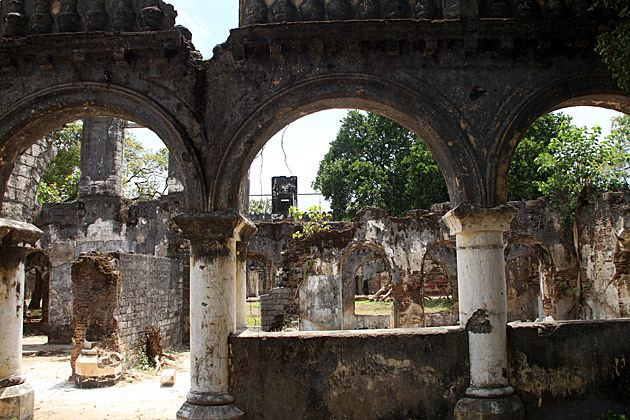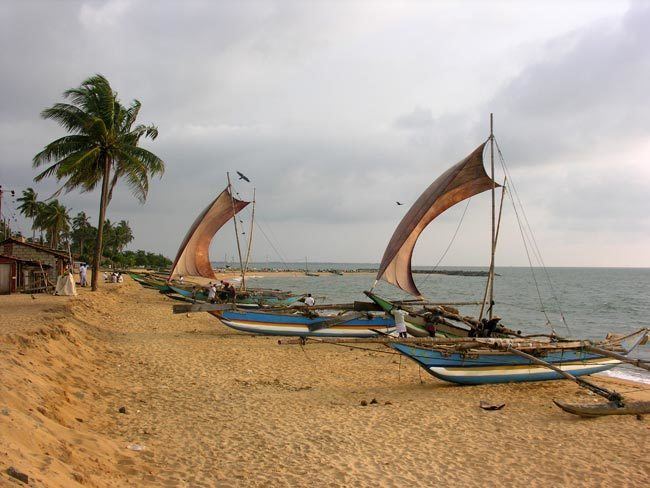Country Area 20.2 km2 | District Jaffna Mayor Yogeswari Patkunarajah (UPFA (EPDP)) | |
Colleges and Universities University of Jaffna, Jaffna Hindu College | ||
Jaffna (Tamil: , Sinhala: ) is the capital city of the Northern Province of Sri Lanka. It is the administrative headquarters of the Jaffna district located on a peninsula of the same name. With a population of 88,138, Jaffna is Sri Lankas 12th largest city. Jaffna is approximately six miles away from Kandarodai which served as a famous emporium in the Jaffna peninsula from classical antiquity. Jaffnas suburb, Nallur served as the capital of the four centuries-long medieval Jaffna kingdom. Prior to the Sri Lankan civil war, it was Sri Lankas second most populated city after the commercial capital Colombo. The 1980s insurgent uprising led to extensive damage, expulsion of part of the population, and military occupation. Since the end of civil war in 2009, refugees and internally displaced people have started to return to their homes and government and private sector reconstruction has begun.
Contents
- Map of Jaffna
- Jaffna town travel video of northern tamil sri lanka
- Slaito jaffna tour 2013 sri lanka
- History
- Geography and climate
- Economy Transportation
- Dry chicken masala indian street food
- Chicken fried rice preparation for 30 people indian street food
- Sbs food my sri lanka with peter kuruvita
- References
Map of Jaffna
Historically, Jaffna has been a contested city. It was made into a colonial port town during the Portuguese occupation of the Jaffna peninsula in 1619. The Dutch, took it from the Portuguese, only to lose it to the British in 1796. After Sri Lanka gained independence 1948, the political relationship between the minority Sri Lankan Tamils and majority Sinhalese worsened and after the Black July pogrom, civil war erupted in 1983. The rebel Liberation Tigers of Tamil Eelam (LTTE) occupied Jaffna in 1986. and from 1989 until 1995. The Indian Peace Keeping Force (IPKF) briefly occupied the city in 1987. The LTTE again occupied the city from 1989 until 1995, when the Sri Lankan military gained control.
Jaffna town travel video of northern tamil sri lanka
The majority of the city’s population are Sri Lankan Tamils, although there was a significant number of Sri Lankan Moors, Indian Tamils and other ethnic groups present in the city prior to the civil war. Most Sri Lankan Tamils are Hindus followed by Christians, Muslims and a small Buddhist minority. The city is home to number of educational institutions established during the colonial and post-colonial period. It also has number of commercial institutions, minor industrial units, banks, hotels and other government institutions such as the hospital. It is home to the popular Jaffna library that was burnt down and rebuilt. The city is anchored by the Jaffna fort rebuilt during the Dutch colonial period.
Slaito jaffna tour 2013 sri lanka
History

Excavations that were conducted by Sir Paul E. Pieris during 1918 and 1919 at the ancient Jaffna capital of Kandarodai and Vallipuram, a coastal town six kilometres from Point Pedro, revealed coins called "puranas", and "kohl" sticks that dated back to 2000 BCE similar in style to the sticks used to paint pictures in Egypt, suggesting that the Northern part of Sri Lanka was a "flourishing" settlement even before the birth of Prince Vijaya, the legendary founder of the Sinhalese.
Geography and climate

The city is surrounded by Jaffna Lagoon to its west and south, Kokkuvil and Thirunelveli to the north, and Nallur to the east. Jaffna peninsula is made of limestone as it was submerged under sea during the Miocene period. The limestone is grey, yellow and white porous type. The entire land mass is flat and lies at sea level. Within one mile of the city center is the island of Mandativu which is connected by a causway. Palmyrah groves can be seen where land has not been used for construction. Other notable vegetation is a leafless shrub called talai (alae africana) and koddanai (oleander).
Jaffna features a tropical rainforest climate with no true dry season month. Jaffna has the highest average temperature in Sri Lanka of 83 °F (28 °C). The temperature is highest in the months of April – May and August – September. The temperature is coolest in December – January. The annual rainfall is brought in by the North East monsoon and it varies from one place to the other and also from year to year. The average rainfall is 50 inches in the western part of Jaffna peninsula.
Economy & Transportation
Jaffna city was founded as a trading town by European merchants. Although a historic port used by the native Jaffna kingdom was already in existence when the Portuguese arrived, it was the European mercantile activity that made it prominent. In colonial times, production of clothes, items of gold and silver, processing of tobacco, rice and other related activities formed an important part of the economic activities. In modern times, the port was its principal source of revenue but it has declined drastically. Currently it survives as a fishing port. The city had a wide range of industries, including food processing, packaging, making of household items, and salt processing, but most ceased after 1995. Since then, most industrialists, entrepreneurs, and business people have relocated to the rest of Sri Lanka and abroad. After 2009, foreign governments within the EU, US, India, and investors from the south of the island and the Sri Lankan Tamil diaspora have shown an interest in making investments in Jaffna district in general and Jaffna city in particular.
